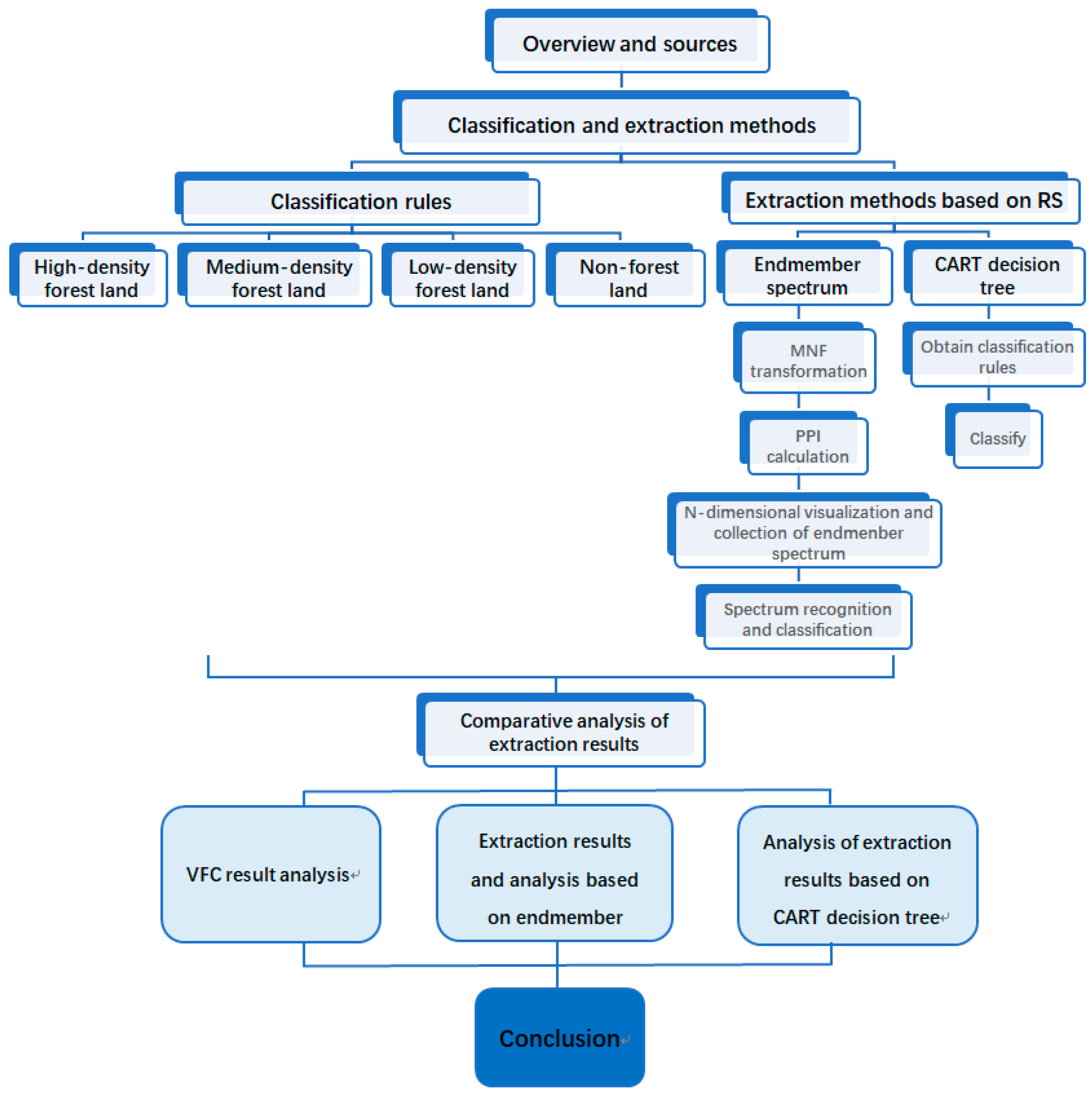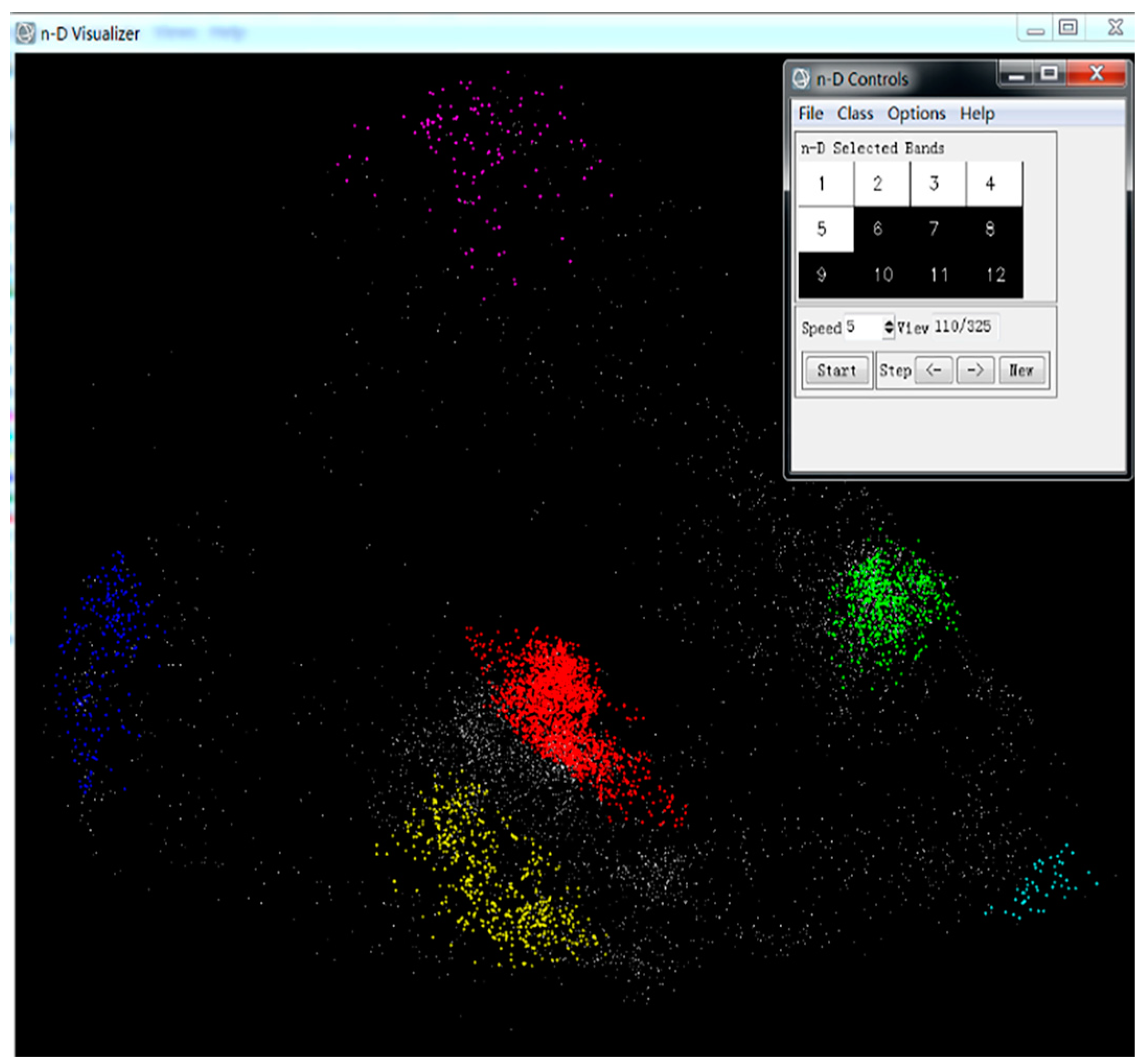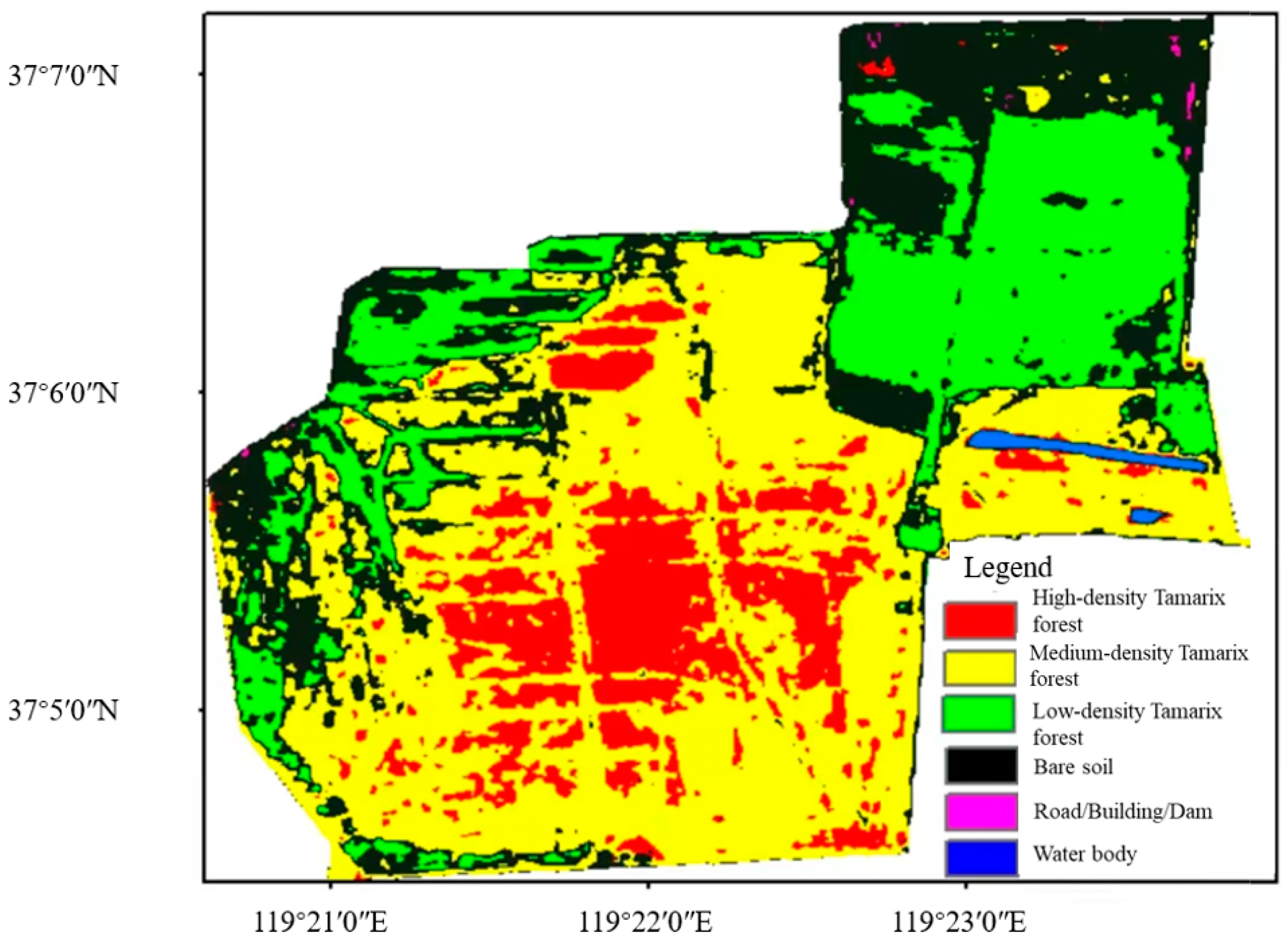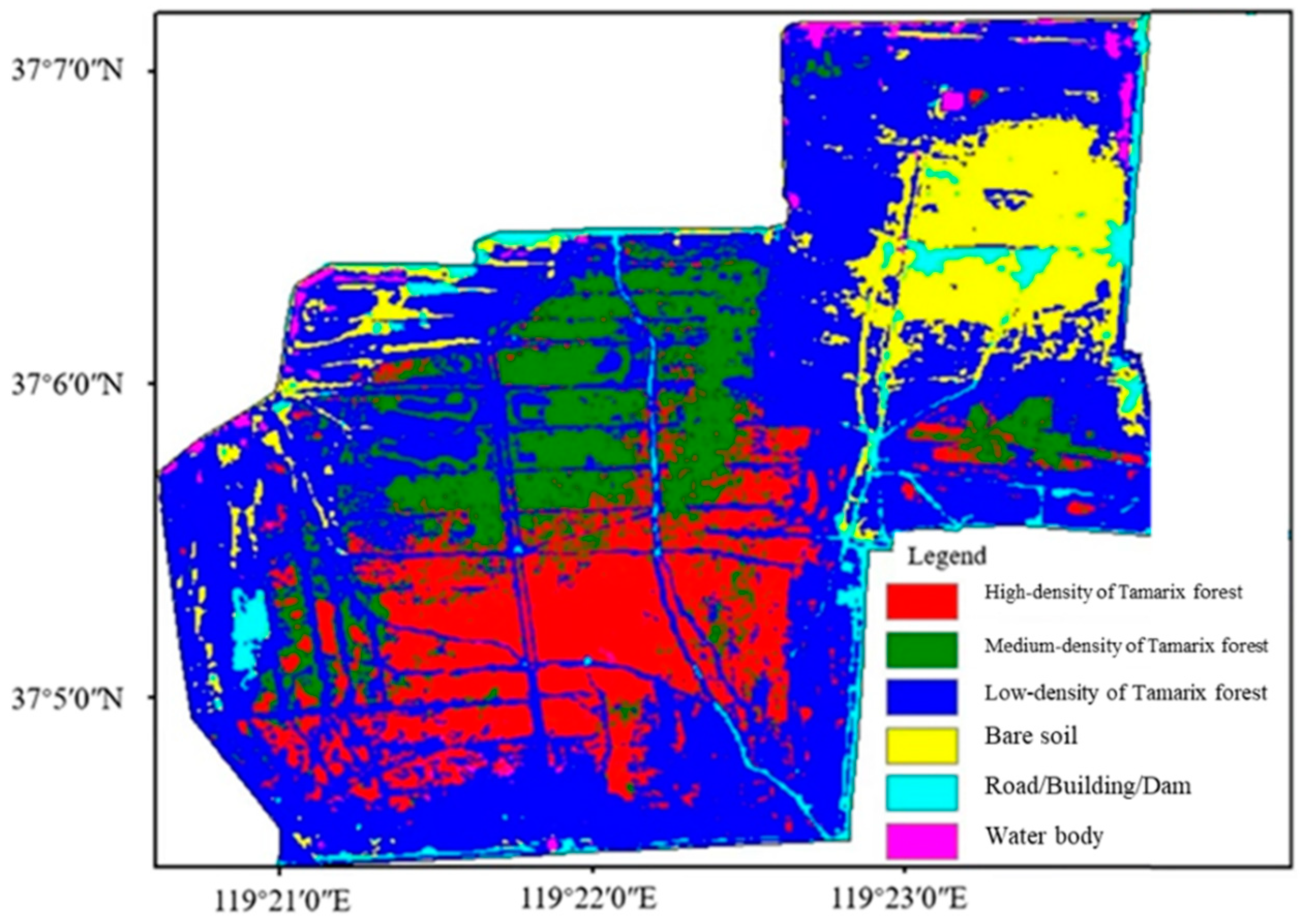Analysis of Land-Use/Cover-Type Extraction Results of Tamarix Shrub Forest of China Based on Remote Sensing Technology
Abstract
:1. Introduction
2. Overview and Data Sources of the Study Area
3. Classification and Extraction Methods
3.1. Classification of Land Use/Cover Types in the Study Area
3.2. Endmember Spectrum Method
3.2.1. MNF Transformation
3.2.2. PPI Calculation
3.2.3. N-Dimensional Visualization and Collection of Endmember Spectrum
3.2.4. Spectrum Recognition and Classification
3.3. CART Decision Tree
4. Comparative Analysis of Extraction Results
4.1. VFC Results Analysis
4.2. Extraction Results and Analysis of Land Use/Cover in the Study Area Based on Endmember Spectrum Method
4.3. Analysis of Land-Use/Cover Extraction Results in the Study Area Based on CART Decision Tree
5. Conclusions
- (1)
- The areas with VFC greater than or less than 0.4 in the study area account for 69.74% and 30.26% of the total area of the Tamarix forest in the study area. It shows that while the overall forest cover of Tamarix forests is high, there is still room for further afforestation and ecological restoration in the protection area, although a small portion of localized area, such as dams, roads, and buildings, are difficult to change their land use/cover attributes.
- (2)
- From the results based on the endmember spectrum method and the CART decision tree method, it could be concluded that the “same object corresponds to different spectrum, and the same spectrum corresponds to different objects”, having a certain impact on the classification and extraction of remote sensing images of shrubbery; at the same time, a relatively low spatial resolution of remote sensing images has an impact on the accuracy of spectral information, which in turn affects the extraction and classification.
- (3)
- From the results of land use/cover extraction based on the endmember spectrum method in the study area, it can be seen that this method has better results when extracting well-grown forested land, such as a high-density Tamarix forest and medium-density Tamarix forest, and poorer results when extracting non-forested land, such as low-density tamarisk forests, roads, buildings, dams, and water bodies.
- (4)
- From the results of the land use/cover extraction based on a CART decision tree in the study area, it can be seen that this method is more effective when extracting non-forested land, such as roads, buildings, dams, and water bodies, but less effective when extracting forested land, such as high-density Tamarix forests, medium-density Tamarix forests, and low-density Tamarix forests.
Author Contributions
Funding
Data Availability Statement
Conflicts of Interest
References
- Cihlar, J.; Latifovic, R.; Trishchenko, A.; Fedosejevs, G.; Beaubien, J.; Chen, J. National Scale Forest Information Extraction from Coarse Resolution Satellite Data, Part 1. Remote Sens. For. Environ. Concepts Case Stud. 2003, 337–357. [Google Scholar] [CrossRef]
- Ma, S.; Wang, L.J.; Jiang, J.; Zhao, Y.G. Land use/land cover change and soil property variation increased flood risk in the black soil region, china, in the last 40 years. Environ. Impact Assess. Rev. 2024, 104, 107314. [Google Scholar] [CrossRef]
- Berman, M.; Kiiveri, H.; Lagerstrom, R.; Ernst, A.; Dunne, R.; Huntington, J.F. ICE: A statistical approach to identifying endmembers in hyperspectral images: Learning from Earth’s Shapes and Colors. IEEE Trans. Geosci. Remote Sens. 2004, 42, 2085–2095. [Google Scholar] [CrossRef]
- Adegun, A.A.; Viriri, S.; Tapamo, J.R. Review of deep learning methods for remote sensing satellite images classification: Experimental survey and comparative analysis. J. Big Data. 2023, 10, 93. [Google Scholar] [CrossRef]
- Denisova, A.Y.; Egorova, A.A.; Sergeyev, V.V.; Kavelenova, L.M. Requirements for multispectral remote sensing data used for the detection of arable land colonization by tree and shrubbery vegetation. Comput. Opt. 2019, 43, 846–856. [Google Scholar] [CrossRef]
- Zhang, J.; Zhou, Q.; Zhuo, L.; Geng, W.; Wang, S. A CBIR system for hyperspectral remote sensing images using endmember extr action. Int. J. Pattern Recogn. 2017, 31, 1752001. [Google Scholar] [CrossRef]
- Yang, H.; Deng, F.; Fu, H.; Zhang, J. Estimation of rape-cultivated area based on decision tree and mixed pixel decomposition. J. Indian Soc. Remote 2021, 49, 1285–1292. [Google Scholar] [CrossRef]
- Phiri, D.; Simwanda, M.; Nyirenda, V.; Murayama, Y.; Ranagalage, M. Decision tree algorithms for developing rulesets for object-based land cover classification. ISPRS Int. J. Geo-Inf. 2020, 9, 329. [Google Scholar] [CrossRef]
- Tsitsi, B.; Silvia, A.; Massim, M.; Adriaan, V.N.; Zoltán, V. A spectral unmixing method with ensemble estimation of endmembers: Application to flood mapping in the caprivi floodplain. Remote Sens. 2017, 9, 1013. [Google Scholar] [CrossRef]
- Xia, J.B.; Zhang, S.Y.; Zhang, G.C.; Xu, J.W.; Shao, H.B. Growth dynamics and soil water ecological characteristics of Tamarix Chinensis Lour. forests with two site types in coastal wetland of Bohai golf. J. Food Agric. Environ. 2013, 11, 1492–1498. [Google Scholar]
- Liu, J.N.; Fang, H.; Liang, Q.; Dong, Y.; Wang, C.; Yan, L.; Ma, X.Z.; Lang, X.; Gai, S.; Wang, L.; et al. Genomic analyses provide insights into the evolution and salinity adaptation of halophyte Tamarix chinensis. GigaScience 2023, 12, giad053. [Google Scholar] [CrossRef]
- Zhu, R.; Mo, N.; Zhuang, L. Class-specific dictionary-based cross-domain scene classification method with reliable target pseudo labels for remote sensing images. Remote Sens. Appl. Soc. Environ. 2023, 33, 101101. [Google Scholar] [CrossRef]
- GB/T 26424-2010; Technical regulations for inventory for forest management planning and design. Standardization Administration of China: Beijing, China, 2010.
- Horton, J.S. The Development and Perpetuation of the Permanent Tamarisk Type in the Phreatophyte Zone of the Southwest; US Department of Agriculture, Forest Service, Rocky Mountain Forest and Range Experiment Station: Fort Collins, CO, USA, 1977; pp. 124–127. [Google Scholar]
- Zhu, J.G.; Wei, M.J.; Lin, L.; Den, Q.L.; Yibo, L.; Weilinag, F. Using vegetation indices and texture measures to estimate vegetation fractional coverage (VFC) of planted and natural forests in Nanjing city, China. Adv. Space Res. 2013, 51, 1186–1194. [Google Scholar] [CrossRef]
- Huo, H.; Sun, C. Spatiotemporal variation and influencing factors of vegetation dynamics based on Geodetector: A case study of the northwest. Yunnan Plateau, China. Ecol. Indic. 2021, 130, 108005. [Google Scholar] [CrossRef]
- Miao, L.; Qi, H.; Szu, H. A maximum entropy approach to unsupervised mixed-pixel decomposition. IEEE T. Image Process. 2007, 16, 1008–1021. [Google Scholar] [CrossRef]
- Syarif, A.M.; Kumara, I.S.W. The effect of minimum noise fraction on multispectral imagery data for vegetation canopy density modelling. Geoplanning J. Geomat. Plann. 2018, 5, 251–258. [Google Scholar] [CrossRef]
- Pei, L.; Yan, C. Study on mixed pixel classification method of remote sensing image based on fuzzy theory. In Proceedings of the Joint Urban Remote Sensing Event, Shanghai, China, 20–22 May 2009; pp. 1–7. [Google Scholar] [CrossRef]
- Chang, C.I.; Li, Y.; Wang, Y. Progressive band processing of fast iterative pixel purity index for finding endmembers. IEEE Geosci. Remote Sens. 2017, 14, 1464–1468. [Google Scholar] [CrossRef]
- Bateson, A.; Curtiss, B. A method for manual endmember selection and spectral unmixing. Remote Sens. Environ. 1996, 55, 229–243. [Google Scholar] [CrossRef]
- Serventi, G.; Carli, C.; Altieri, F.; Geminale, A.; Sgavetti, M. Spectral classification and MGM-based mineralogical characterization of hydrated phases: The Nili Fossae case, Mars. Planet. Space Sci. 2021, 209, 105361. [Google Scholar] [CrossRef]
- Friedl, M.A.; Brodley, C.E. Decision tree classification of land cover from remotely sensed data. Remote Sens. Environ. 1997, 61, 399–409. [Google Scholar] [CrossRef]
- Tangirala, S. Evaluating the impact of GINI index and information gain on classification using decision tree classifier algorithm. Int. J. Adv. Comput. Sc. 2020, 11, 612–619. [Google Scholar] [CrossRef]
- Jacobson, C.R. The effects of endmember selection on modelling impervious surfaces using spectral mixture analysis: A case study in sydney, australia. Int. J. Remote Sens. 2014, 35, 715–737. [Google Scholar] [CrossRef]
- Wang, W.; Yao, X.; Ji, M.; Zhang, J. Spectral data treatments for impervious endmember derivation and fraction mapping from landsat etm+ imagery: A comparative analysis. Front. Earth Sci. 2015, 9, 179–191. [Google Scholar] [CrossRef]
- Luna, J.M.; Gennatas, E.D.; Ungar, L.H.; Eaton, E.; Diffenderfer, E.S.; Jensen, S.T.; Simonell, C.B.; Friedman, J.; Solberg, T.D.; Valdes, G. Building more accurate decision trees with the additive tree. Proc. Natl. Acad. Sci. USA 2019, 116, 19887–19893. [Google Scholar] [CrossRef] [PubMed]
- Zhang, N.; Wu, Y.; Zhang, Q. Detection of sea ice in sediment laden water using MODIS in the Bohai Sea: A CART decision tree method. Int. J. Remote Sens. 2015, 36, 1661–1674. [Google Scholar] [CrossRef]
- Hu, Y.; Tian, B.; Yuan, L.; Li, X.; Sun, C. Mapping coastal salt marshes in China using time series of Sentinel-1 SAR. ISPRS J. Photogramm. Remote Sens. 2021, 173, 122–134. [Google Scholar] [CrossRef]
- Rajabi, R.; Ghassemian, H. Spectral unmixing of hyperspectral imagery using multilayer NMF. IEEE Geosci. Remote Sens. 2014, 12, 38–42. [Google Scholar] [CrossRef]
- Li, Y.Q.; Zuo, X.Q.; Li, H.Z. Classification of mangrove population based on worldview-2: A case study of shenzhen bay. Software 2020, 41, 134–138. (In Chinese) [Google Scholar]
- Li, X.; Liu, K.; Zhu, Y.H. Species classification of mangroves based on resource three satellite imagery. Remote Sens. Technol. Appl. 2018, 33, 360–369. (In Chinese) [Google Scholar]
- Narayanan, R.M.; Desetty, M.K.; Reichenbach, S.E. Effect of spatial resolution on information content characterization in remote sensing imagery based on classification accuracy. Int. J. Remote Sens. 2002, 23, 537–553. [Google Scholar] [CrossRef]
- Zhao, J.; Zhong, Y.; Hu, X.; Wei, L.; Zhang, L. A robust spectral-spatial approach to identifying heterogeneous crops using remote sensing imagery with high spectral and spatial resolutions. Remote Sens. Environ. 2020, 239, 111605. [Google Scholar] [CrossRef]
- Chen, L.; Lin, H.; Sun, H. Extraction of forest information based on decision tree classification. J. Cent. South Univ. For. Technol. 2013, 33, 46–51. (In Chinese) [Google Scholar]
- Zhang, X. Automatic extraction of mangrove information from landsat 8 OLI images based on decision tree method. Remote Sens. Land Resour. 2016, 28, 182–187. (In Chinese) [Google Scholar]









| Method | Advantage | Disadvantage |
|---|---|---|
| Endmember spectrum method | The MNF transformation is used to separate noise from the data, thereby reducing the dimensionality of the data and minimizing the workload of subsequent processing tasks. Additionally, the MNF transformation eliminates the correlation between different bands, further reducing noise [25]. | The PPI is sensitive to noise data and requires MNF transformation for noise reduction. There is no appropriate rule for the selection of the dimension of PPI dimensionality reduction. The PPI does not provide a method for determining the number of endmembers. After PPI endmember extraction, it is necessary to further manually determine the endmembers with the help of N-dimensional visualization [26]. |
| CART decision tree method | The classification rules and process are intuitive and consistent with the human cognitive process, and its best feature is that it can utilize multi-source data [27]. | It has a clear structure, speed, simplicity, and effectiveness. In particular, it can obtain nodes and thresholds based on the selected training samples, eliminating the need for repeated trials to determine thresholds. This approach avoids the subjectivity inherent in traditional expert knowledge-based methods [28]. |
| Classification | VFC | Area/km2 | Percentage of the Area/% |
|---|---|---|---|
| Non-forest land | <0.1 | 0.92 | 5.94 |
| 0.1–0.2 | 1.49 | 9.61 | |
| Low-density forest land | 0.2–0.3 | 1.29 | 8.32 |
| 0.3–0.4 | 0.99 | 6.39 | |
| Medium-density forest land | 0.4–0.5 | 1.10 | 7.10 |
| 0.5–0.6 | 2.52 | 16.26 | |
| 0.6–0.7 | 4.06 | 26.19 | |
| High-density forest land | 0.7–0.8 | 2.83 | 18.26 |
| 0.8–0.9 | 0.28 | 1.81 | |
| 0.9–1.0 | 0.02 | 0.13 | |
| Total | 15.50 | 100.00 | |
Disclaimer/Publisher’s Note: The statements, opinions and data contained in all publications are solely those of the individual author(s) and contributor(s) and not of MDPI and/or the editor(s). MDPI and/or the editor(s) disclaim responsibility for any injury to people or property resulting from any ideas, methods, instructions or products referred to in the content. |
© 2024 by the authors. Licensee MDPI, Basel, Switzerland. This article is an open access article distributed under the terms and conditions of the Creative Commons Attribution (CC BY) license (https://creativecommons.org/licenses/by/4.0/).
Share and Cite
Wang, J.; Liu, R.; Zhang, Y.; Cheng, X.; Xu, J.; Liu, Y.; Chen, F. Analysis of Land-Use/Cover-Type Extraction Results of Tamarix Shrub Forest of China Based on Remote Sensing Technology. Forests 2024, 15, 1179. https://doi.org/10.3390/f15071179
Wang J, Liu R, Zhang Y, Cheng X, Xu J, Liu Y, Chen F. Analysis of Land-Use/Cover-Type Extraction Results of Tamarix Shrub Forest of China Based on Remote Sensing Technology. Forests. 2024; 15(7):1179. https://doi.org/10.3390/f15071179
Chicago/Turabian StyleWang, Jin, Ruiting Liu, Yanhua Zhang, Xiaoxiang Cheng, Jingtao Xu, Yaohui Liu, and Feiyong Chen. 2024. "Analysis of Land-Use/Cover-Type Extraction Results of Tamarix Shrub Forest of China Based on Remote Sensing Technology" Forests 15, no. 7: 1179. https://doi.org/10.3390/f15071179
APA StyleWang, J., Liu, R., Zhang, Y., Cheng, X., Xu, J., Liu, Y., & Chen, F. (2024). Analysis of Land-Use/Cover-Type Extraction Results of Tamarix Shrub Forest of China Based on Remote Sensing Technology. Forests, 15(7), 1179. https://doi.org/10.3390/f15071179









